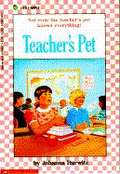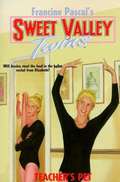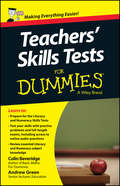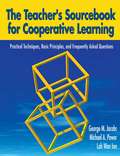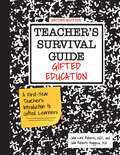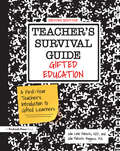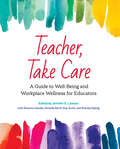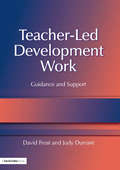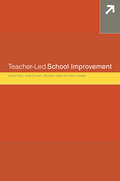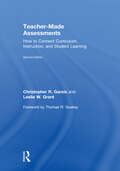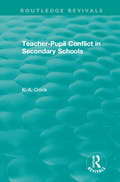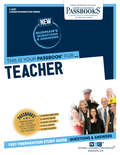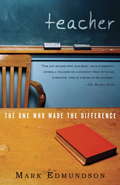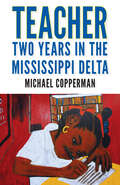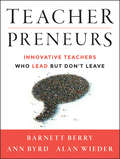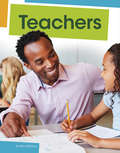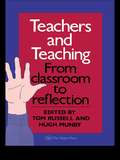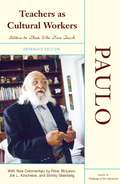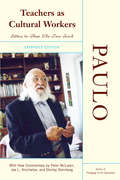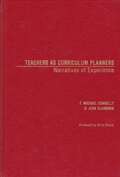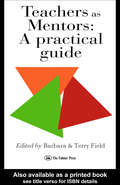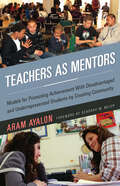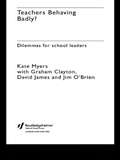- Table View
- List View
Teacher's Pet
by Johanna HurwitzNine-year-old Cricket's expectations of being, as always, the teacher's favorite student are dashed by the arrival of an unusual new girl in her fourth-grade class.
Teacher's Pet (Sweet Valley Twins #2)
by Jamie Suzanne Francine PascalPlaying favorites ... Elizabeth and Jessica Wakefield are the best dancers in their ballet class. Both girls want to dance the solo in the upcoming recital. Elizabeth hates to compete with her sister, but Jessica doesn't mind at all. She knows she's a better dancer than her twin. The problem is their ballet teacher. No matter what Jessica does, Madame Andre never notices her. But she's always praising Elizabeth. It's not fair and Jessica isn't going to settle for second best just because her twin sister is the teacher's pet.
Teacher's Skills Tests For Dummies
by Colin Beveridge Andrew GreenIf you’re preparing for the newly revised Numeracy and Literacy Skills Tests, Teacher’s Skills Tests For Dummies is your one-stop for both exams, providing you with subject-matter review, revision and practice tests you need to tackle the tests with confidence and succeed. Written by expert authors in Maths, English, and Education (with the credentials to prove it), Teacher’s Skills Tests For Dummies provides you with: - A review of the key maths and English concepts you need to know to do well - Full length practice tests and tons of additional practice questions - Online accessible audio tests for spelling and mental arithmetic — to better prepare you for the actual test - Tips and tricks (along with mistakes to avoid) to become a better test taker With this book — and a bit of work on your part — you’ll be positioned to pass your skills tests and gain that coveted place on a teacher-training course.
Teacher's Sourcebook for Cooperative Learning: Practical Techniques, Basic Principles, and Frequently Asked Questions
by Max StromA dynamic team of authors demonstrates how any classroom teacher can use cooperative learning techniques for lesson planning, classroom management, and improving students' collaboration skills.
Teacher's Survival Guide: A First-Year Teacher's Introduction to Gifted Learners
by Julia Roberts Julia Roberts BoggessTeacher's Survival Guide: Gifted Education is packed with practical information, up-to-date resources, tips for success, and advice from experts in the field. This updated second edition:Is the perfect introduction to gifted education for beginning and early career educators.Provides field-tested, proven strategies.Is designed to help teachers build their understanding of gifted education and gifted learners.Covers topics essential to gifted education teachers, including identifying giftedness and encouraging creativity.Includes tips for providing resources and opportunities to spur talent development.Each chapter features a key question, making the book ideal for an engaging book study, as well as survival tips and a survival toolkit of resources to keep readers on course as they navigate through gifted ed.
Teacher's Survival Guide: Gifted Education, A First-Year Teacher's Introduction to Gifted Learners
by Julia Link Roberts Julia Roberts BoggessTeacher's Survival Guide: Gifted Education is packed with practical information, up-to-date resources, tips for success, and advice from experts in the field. This updated second edition:Is the perfect introduction to gifted education for beginning and early career educators.Provides field-tested, proven strategies.Is designed to help teachers build their understanding of gifted education and gifted learners.Covers topics essential to gifted education teachers, including identifying giftedness and encouraging creativity.Includes tips for providing resources and opportunities to spur talent development.Each chapter features a key question, making the book ideal for an engaging book study, as well as survival tips and a survival toolkit of resources to keep readers on course as they navigate through gifted ed.
Teacher, Take Care: A Guide to Well-Being and Workplace Wellness for Educators
by Megan Hunter Keith Macpherson Cher Brasok Monika Cichosz Rosney Laura Doney Dana Fulwiler Volk Jackie Gagné Kelsey McDonald Lisa Dumas Neufeld Sandra Pacheco Melo Richelle North Scott Joyce SunadaTeaching can be a highly satisfying profession, but it can also be overwhelming. Stress management. Self-care. Mental well-being. Mindfulness. These words have become all too familiar, but what do they actually mean for you? And how can they help without adding to your to-do list?All teachers have different experiences and different needs. Through stories by diverse educators, this professional resource invites you to try different wellness strategies, explore varying perspectives, and consider new ideas of what it means to &“be well.&”Grounded in servant leadership and a holistic model, each chapter connects to Indigenous perspectives of wellness through remarks from Elder Stanley Kipling and Knowledge Keeper Richelle North Star Scott.
Teacher, Take Care: A Guide to Well-Being and Workplace Wellness for Educators
by Megan Hunter Keith Macpherson Cher Brasok Monika Cichosz Rosney Laura Doney Dana Fulwiler Volk Jackie Gagné Kelsey McDonald Lisa Dumas Neufeld Sandra Pacheco Melo Richelle North Scott Joyce SunadaTeaching can be a highly satisfying profession, but it can also be overwhelming. Stress management. Self-care. Mental well-being. Mindfulness. These words have become all too familiar, but what do they actually mean for you? And how can they help without adding to your to-do list?All teachers have different experiences and different needs. Through stories by diverse educators, this professional resource invites you to try different wellness strategies, explore varying perspectives, and consider new ideas of what it means to &“be well.&”Grounded in servant leadership and a holistic model, each chapter connects to Indigenous perspectives of wellness through remarks from Elder Stanley Kipling and Knowledge Keeper Richelle North Star Scott.
Teacher-Led Development Work: Guidance and Support
by David Frost Judy DurrantThis is a practical step-by-step guide to how the quality of teaching and learning in schools can be improved through the development of organizational capacity and professional networking. Whether you're involved in the National College of School Leadership's Networked Learning Communities scheme, or simply wish to enable teachers to initiate and sustain education change, this replacement to David Frost's earlier Reflective Action Planning for Teachers will be of great benefit. The book demonstrates how secondary and primary teachers can contribute fully to the improvement of their school, while pursuing their own continued professional development and gaining accreditation through school-based work. It provides guidelines for school managers, higher education tutors, external consultants and LEA advisors establishing school-based support, and gives tried and tested flexible proformas, checklists and other practical tools that are ideal for training, INSET or a personal audit.
Teacher-Led School Improvement
by David Frost Gary Holden Michael Head Judith DurrantA fresh look at school improvement from the perspective of professional development.There are many things that teachers can do to improve the conditions for learning and teaching in their own schools. This book shows how staff can take the initiative and identify areas in their school in need of attention, and tackle them. It provides case-study accounts of schemes in a number of schools, together with accounts of the action research based development work undertaken by teachers to improve their schools. The studies illuminate issues such as: improving the quality of learning and teaching; developing an effective school council; building partnerships and community schemes; developing economic and industrial understanding.
Teacher-Led School Improvement
by David Frost Gary Holden Michael Head Judith DurrantA fresh look at school improvement from the perspective of professional development. There are many things that teachers can do to improve the conditions for learning and teaching in their own schools. This book shows how staff can take the initiative and identify areas in their school in need of attention, and tackle them. It provides case-study accounts of schemes in a number of schools, together with accounts of the action research based development work undertaken by teachers to improve their schools. The studies illuminate issues such as: improving the quality of learning and teaching; developing an effective school council; building partnerships and community schemes; developing economic and industrial understanding.
Teacher-Made Assessments: How to Connect Curriculum, Instruction, and Student Learning
by Christopher Gareis Leslie GrantAssessment is not only a measure of student learning, but a means to student learning. This bestselling book guides you in constructing and using your own classroom assessments, including tests, quizzes, essays, and rubrics to improve student achievement. You will learn how to weave together curriculum, instruction, and learning to make assessment a more natural, useful part of teaching. Find out how to... ensure your assessments are fair, reliable, and valid; construct assessments that meet the level of cognitive demand expected of students; create select-response items and understand technology-enhanced items that are increasingly being used on assessments; use constructed-response items and develop scoring criteria such as rubrics; and analyze student results on assessments and use feedback more effectively. This second edition features updated examples that reflect the Common Core State Standards as well as other content standards and new, useful samples of teacher-friendly techniques for strengthening classroom assessment practices. No matter what grade level or subject area you teach, this practical book will become your go-to resource for designing effective assessments.
Teacher-Pupil Conflict in Secondary Schools (Routledge Revivals)
by K. A. CronkPublished in 1987, the central question with which this book is concerned is what can, and should, teachers do about teacher-pupil conflict in schools? Few teachers in secondary education would need to have this sort of conflict described as even if that have been fortunate enough to avoid it themselves they will know of it from staffroom discussion and from the media. In can be seen in disorderly classrooms where pupils ‘mess about’ and ‘have a laugh’, and in the bleak expression on the face of their teacher. Equally it can be detected in those classrooms where the teacher is in firm control, but where pupils gaze listlessly out of the window, or only minimally comply with work demands. It is characterized by sudden blazing temper on both sides, and also by long periods of weariness, boredom and disengagement. It is not that conflict which might arise from temporary private troubles, from having a bad day or going through a bad patch, for it is there week in week out, and involves significant numbers. Such conflict has been of interest to both psychologists and sociologists of education and important contributions have been offered by both of these disciplines. Sociologists have mapped out the differing cultural values and norms which appear to promote it. They have identified the social constraints present within the environment in which it is produced, constraints which emanate from the socio-economic organization of society and from the maintenance of an institutional framework, and which affect the micro-dynamics of teacher-pupil interaction. Psychologists have described the effects on behaviour of genetic factors, environmental conditions and cognitive states. Important though such insights are, however, they can only speak indirectly to teacher practice. This book provides an educational approach to the subject discussing topics including theoretical considerations, teacher-pupil discussion and relationships between classroom behaviour and the curriculum. It will appeal to those involved with schools and education, as well as psychologists, educational sociologists and researchers.
Teacher: Passbooks Study Guide (Career Examination Series #Vol. 18)
by National Learning CorporationThe Teacher Passbook® prepares you for your test by allowing you to take practice exams in the subjects you need to study. It provides hundreds of questions and answers in the areas that will likely be covered on your upcoming exam, including but not limited to: Principles of learning and instructions; Principles of curriculum development and the evaluation of instructional materials; Classroom practices; and more.
Teacher: The One Who Made the Difference
by Mark EdmundsonIn 1969, Mark Edmundson was a typical high school senior in working-class Medford, Massachusetts. He loved football, disdained schoolwork, and seemed headed for a factory job in his hometown--until a maverick philosophy teacher turned his life around. When Frank Lears, a small, nervous man wearing a moth-eaten suit, arrived at Medford fresh from Harvard University, his students pegged him as an easy target. Lears was unfazed by their spitballs and classroom antics. He shook things up, trading tired textbooks for Kesey and Camus, and provoking his class with questions about authority, conformity, civil rights, and the Vietnam War. He rearranged seats and joined in a ferocious snowball fight with Edmundson and his football crew. Lears's impassioned attempts to get these kids to think for themselves provided Mark Edmundson with exactly the push he needed to break away from the lockstep life of Medford High. Written with verve and candor, Teacher is Edmundson's heartfelt tribute to the man who changed the course of his life.
Teacher: Two Years in the Mississippi Delta
by Michael CoppermanWhen Michael Copperman left Stanford University for the Mississippi Delta in 2002, he imagined he would lift underprivileged children from the narrow horizons of rural poverty. Well-meaning but naïve, the Asian American from the West Coast soon lost his bearings in a world divided between black and white. He had no idea how to manage a classroom or help children navigate the considerable challenges they faced. In trying to help students, he often found he couldn't afford to give what they required--sometimes with heartbreaking consequences. His desperate efforts to save child after child were misguided but sincere. He offered children the best invitations to success he could manage. But he still felt like an outsider who was failing the children and himself.Teach For America has for a decade been the nation's largest employer of recent college graduates but has come under increasing criticism in recent years even as it has grown exponentially. This memoir considers the distance between the idealism of the organization's creed that "One day, all children in this nation will have the opportunity to attain an excellent education and reach their full potential" and what it actually means to teach in America's poorest and most troubled public schools.Copperman's memoir vividly captures his disorientation in the divided world of the Delta, even as the author marvels at the wit and resilience of the children in his classroom. To them, he is at once an authority figure and a stranger minority than even they are--a lone Asian, an outsider among outsiders. His journey is of great relevance to teachers, administrators, and parents longing for quality education in America. His frank story shows that the solutions for impoverished schools are far from simple.
Teacherpreneurs: Innovative Teachers Who Lead But Don't Leave
by Alan Wieder Barnett Berry Ann ByrdWe need a bold new brand of teacher leadership that will create opportunities for teachers to practice, share, and grow their knowledge and expertise. This book is about "teacherpreneurs"—highly accomplished classroom teachers who blur the lines of distinction between those who teach in schools and those who lead them. These teacherpreneurs embody the concept that teachers can teach as well as lead the transformation of teaching and learning. It’s about empowering expert teachers who can buoy the image of teaching and enforce standards among their ranks while all along making sure that their colleagues as well as education policymakers and the public know what works best for students. The book follows a small group of teacherpreneurs in their first year. We join their journey toward becoming teacher leaders whose work is not defined by administrative fiat, but by their knowledge of students and drive to influence policies that allow them and their colleagues to teach more effectively. The authors trace the teacherpreneurs' steps—and their own—in the effort to determine what it means to define and execute the concept of "teacherpreneurism" in the face of tough demands and resistant organizational structures.
Teachers (Jobs People Do)
by Mary MeinkingTeachers help students become excellent learners and wonderful adults. Readers will find out the different types of roles teachers have, the tools they use, and how people get this rewarding and difficult job.
Teachers And Teaching: From Classroom To Reflection
by Hugh MunbyThe intention of this book is to develop an increased awareness of the place of professional practice in the realms of research in teaching. The chapters investigate, from an international perspective, the emerging reflective methods of collaboration between practitioners and researchers, appreciation of teachers and teaching, and greater understanding of what they aim to promote.
Teachers As Cultural Workers
by Paulo FreireIn Teachers as Cultural Workers, Freire speaks directly to teachers about the lessons learned from a lifetime of experience as an educator and social theorist. Freire's words challenge all who teach to reflect critically on the meaning of the act of teaching as well as the meaning of learning. He shows why a teacher's success depends on a permanent commitment to learning and training, as part of an ongoing appraisal of classroom practice. By opening themselves to recognition of the different roads students take in order to learn, teachers will become involved in a continual reconstruction of their own paths of curiosity, opening the doors to habits of learning that will benefit everyone in the classroom.In essays new to this edition, well-known and respected educators Peter McLaren, Joe Kincheloe, and Shirley Steinberg add their reflections on the relevance of Freire's work to the study and practice of education across the globe.
Teachers As Cultural Workers: Letters To Those Who Dare Teach (Critical Studies In Education Theory)
by Paulo FreireThis book contains letters that show why a teacher's success depends on a permanent commitment to learning and training, as part of an ongoing appraisal of classroom practice. It challenges all teachers to reflect critically on the meaning of the act of teaching as well as the meaning of learning.
Teachers As Curriculm Planners: Narratives Of Experience
by F. Michael Connelly Jean D. ClandininThis is a book for teachers. It is a book for preservice, novice, and experienced teachers. It is a book that celebrates the experience of each and every one of us who teaches. We show, often in the words of teachers with whom we have worked, how reflection on our narratives of experience helps us make meaning of our lives as teachers.
Teachers As Mentors: A Practical Guide
by Terry FieldSchool-based teacher education is being implemented and this book explores the changing role and function of the supervisory teacher in the classroom.; The ramifications of the changes to pre-service teacher training are enormous. The staffing of some parts of universities will be affected dramatically; the distribution of funds will change; the tasks of many teachers in school will be different as they find themselves becoming teacher educators rather than supervisors in their new role as mentors. In this highly readable book, the Fields, through a series of case studies, drawn from the UK and Australia, focus on the changing roles and responsibilities of those central to the preparation of the next generation of teachers.; Chapters consider the overall effect that mentoring will have on the teaching profession. The book looks at the skills required by teachers and, in particular, the beginning teacher; the experiences of teachers in-training undergoing education programmes; teachers' supervisory roles; and how universities will be affected by the changes.; Practical guidance is given for teachers becoming mentors and how mentoring can lead to professional development and as a way forward in teachers' careers.
Teachers As Mentors: Models for Promoting Achievement with Disadvantaged and Underrepresented Students by Creating Community
by Aram AyalonThe book describes two similar and successful models of youth mentoring used by two acclaimed urban high schools that have consistently achieved exceptional graduation rates. Providing a detailed description of their methods – based upon extensive observation, and interviews with teachers, students, administrators, and parents – this book makes a major contribution to the debate on how to reduce the achievement gap.Using similar teacher-as-youth mentor and youth advising models, these two inner city schools – Fenway High School in Boston, Massachusetts; and the Kedma School in Jerusalem – have broken the cycle of failure for the student populations they serve—children from underrepresented groups living in poverty in troubled neighborhoods with few resources. Students in both schools have excelled academically, rarely dropout, and progress to college in significant numbers (Fenway has 90% graduation rate, with 95% of graduates going on to college. Kedma outperforms comparable urban schools by a factor of four). Both schools have won numerous awards, with Fenway High School gaining Pilot School status in Massachusetts, a recognition the state only awards to a few exemplary schools; and Kedma School being declared one of the 50 most influential educational endeavors in Israel.The success of both schools is directly attributable to their highly developed teacher-as-a-youth mentor programs that embody an ideology and mission that put students at the center of their programs and structures. The models are closely integrated with the curriculum, and support the social, emotional, cultural, and academic needs of students, as well as develop close mentor-student-parent relationships. The model furthermore includes extensive support for the mentors themselves. Apart from the potential of these models to narrow the achievement gap, these two schools have a record of creating a school climate that promotes safety, and reduces the incidence of bullying and violence. At the heart of both programs is creating community—between departments and functions in the school; and between teachers, staff, students, and parents. Everyone in the school system should read this book.Research suggests that caring relationships between students and teachers significantly enhance Social Emotional Learning (SEL) -- defined as the process through which children develop their ability to integrate thinking, feeling, and behaving to achieve important life tasks -- which is recognized as an important factor in children's success in school. However, caring schools are usually the exception, especially at the secondary level where relationships between students and teachers seem to deteriorate significantly. This book provides a schoolwide model for establishing caring secondary schools and enhancing SEL using a teacher-as-a youth mentor model.
Teachers Behaving Badly?: Dilemmas for School Leaders
by David James Kate Myers Graham Clayton Jim O’BrienBehaviour that involves an abuse of a teacher's position of trust or a breach of the standards of propriety is regarded as misconduct and may lead to a teacher being barred from the teaching profession. This book offers the school leader advice on making decisions arising from misconduct or alleged misconduct of their staff. It addresses issues such as: how to deal with an allegation of a teacher's sexual misconduct how to judge when a relationship between a pupil and teacher becomes abusive how to decide what to do about drug abuse how to support an 'outed' gay or lesbian teacher how to decide when private matters become public ones how to deal with the media. Often there are no clear-cut answers, or easy solutions, but this book will raise the dilemmas and explain the employment and criminal law in jargon-free language. School leaders have to make important decisions about such incidents, considering their responsibility to their staff, to the local community, and to their pupils. Leadership training rarely includes exposure to these issues, but most people working in schools may have to face them at some point in their career. Teachers Behaving Badly draws on real cases and explores the dilemmas faced, offering practical and legal advice to help school leaders prepare for such critical incidents.
